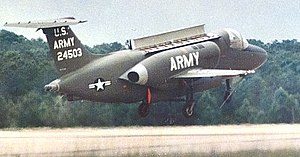Lockheed XV-4
| Lockheed XV-4 Hummingbird | |
|---|---|
 Lockheed XV-4 "Hummingbird" |
|
| Type: | V / STOL - experimental aircraft |
| Design country: | |
| Manufacturer: | |
| First flight: |
June 2, 1962 |
| Commissioning: |
Never put into service |
| Production time: |
Was never mass-produced |
| Number of pieces: |
2 |
The Lockheed XV-4 Hummingbird (Hummingbird) (original identification VZ-10 after the designation system for aircraft of the US Army from 1956 to 1962 ) was a constructed in the 1960s and tested VTOL - experimental aircraft .
history
After the principle of vertical take-off with a vertical aircraft ( tail sitter ) in the form of the Ryan X-13 Vertijet was abandoned, new technologies had to be considered. Attempts were made to develop a technique to equip horizontally aligned vertical takeoffs ( flat risers ) with more thrust than the engines themselves nominally produce ( jet augmentation ). Two companies, Lockheed-Georgia and General Electric (in collaboration with Ryan), were hired to develop experimental aircraft capable of testing the new radical ideas.
"Jet augmentation"
The principle of jet augmentation , translated into German as jet or thrust reinforcement, was first described by Theodore von Kármán in 1949. It is a remarkably simple theory that combines the law of conservation of momentum with Bernoulli's law of flow . The exhaust gas from the jet engine enters a large chamber before it exits through an opening on the other side. As the hot and rapid exhaust air leaves the chamber, it draws ambient air into the chamber to compensate. The kinetic energy of the sucked in air then leads to an additional thrust.
construction
To test the principle in practice, Lockheed built a flying test rig in early 1959 . Initially powered by two Fairchild J44 engines, it was possible to lift a weight of 2600 lb vertically with a nominal engine thrust of 2000 lb, which corresponds to a thrust gain of about 30%. With more powerful Continental J69 engines, a 45% boost in thrust was later achieved. Various concept studies were then drawn up for an emergency aircraft under the collective names GL-224 and GL-228.
In August 1959, Lockheed presented the finished design, called the Model 330 Hummingbird, to the US Army Transport Research Command as an integrated VTOL aircraft for battlefield surveillance and target acquisition. The order from the US Army in July 1961 only included the construction of two test aircraft, as the proposed technology was not considered to have been sufficiently tested. The aircraft received the US Army designation VZ-10 (s / n 62-4503 and 62-4504).
Two Pratt & Whitney JT12 A-PW-3s provided both lift and propulsion thrust. The dimensions of the fuselage and its bulky appearance resulted primarily from the size of the mixing chamber required. The mixing chamber is located in the fuselage between the engines and is covered by flaps on the top and bottom of the fuselage in level flight. There are nozzles at all outer points of the aircraft for control purposes. The exhaust jet is tapped at the bow and stern nozzle, while compressed air from the compressors is used for the two nozzles at the wing tips.
testing
The first conventional flight of the first prototype (XV-4A, 62-4503) took place on July 7, 1962. The first tethered hover was performed on November 30, 1962, the first free hover on May 24, 1963. The first flight with the transition from hovering to aerodynamically supported forward flight and back to hovering took place on November 8, 1963.
This prototype crashed in Cobb County on June 10, 1964 , killing the pilot.
Lockheed modified the second XV-4A to the XV-4B (62-4504) in late 1966 or 1968. The two engines (Pratt & Whitney JT12A-PW-3) with 1361 kg thrust each were replaced by six engines ( General Electric J85 -GE-19) with 1368 kg thrust each. Four engines functioned as pure lift engines and were installed in the middle of the fuselage to replace the mixing chamber. The second plane with pilot Harlan J. Quamme at the controls crashed on March 14, 1969 in Georgia . The pilot survived unharmed thanks to his ejection seat.
Technical data (first prototype)
| Parameter | Data |
|---|---|
| crew | 1 (the right seat was always occupied with test equipment) |
| length | 10.3 m (32 ft) |
| span | 7.92 m (26 ft) |
| height | 3.58 m (11 ft 8 in) |
| Empty weight | 2268 kg (5000 lb) |
| Takeoff weight | 3266 kg (7200 lb) |
| Top speed | 541 km / h (336 mph) |
| Engines | 2 × Pratt & Whitney JT12A, 29.37 kN total (6600 lb) thrust |
literature
- Aeronautical engineering and aerospace engineering Volume 10 (1964) No. 3
- VTOL flat-risers - Lockheed XV-4 and Ryan / GE XV-5 . In: International Air Power Review, Vol. 16, 2005.
Individual evidence
- ↑ Photos with explanations at xplanes (French)
Web links
- Lockheed H to Z (EN)
- Lockheed XV-4A on vertipedia.vtol.org (EN)
- Lockheed XV-4B on vertipedia.vtol.org (EN)